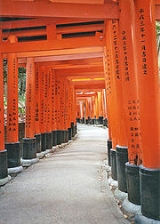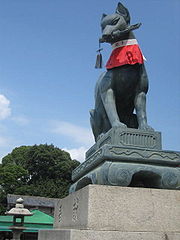
Inari Shrine
Encyclopedia
is a shinto shrine to worship the god Inari. There are many Inari shrines in Japan. The deity is worshiped also in some Buddhist temples.
 Inari is a popular deity with shrines and Buddhist temples located throughout most of Japan
Inari is a popular deity with shrines and Buddhist temples located throughout most of Japan
. According to a 1985 survey by the National Association of Shinto Shrines, 32,000 shrines — more than one-third of Shinto shrines in Japan — are dedicated to Inari. This number includes only Shinto shrines with full-time resident priests; if small roadside or field shrines, shrines kept in a home or corporate office, smaller shrines without full-time resident priests, and Buddhist temples were included, the number would increase by at least an order of magnitude.
The entrance to an Inari shrine is usually marked by one or more vermilion
torii
and some statues of kitsune
, which are often adorned with red yodarekake (votive bibs) by worshippers out of respect. This red color has come to be identified with Inari, because of the prevalence of its use among Inari shrines and their torii. The main shrine is the Fushimi Inari Shrine in Fushimi, Kyoto, Japan, where the paths up the shrine hill are marked in this fashion.
The kitsune statues are at times taken for a form of Inari, and they typically come in pairs, representing a male and a female. These fox statues hold a symbolic item in their mouths or beneath a front paw — most often a jewel and a key, but a sheaf of rice, a scroll, or a fox cub are all common. Almost all Inari shrines, no matter how small, will feature at least a pair of these statues, usually flanking or on the altar or in front of the main sanctuary. The statues are rarely realistic; they are typically stylized, portraying a seated animal with its tail in the air looking forward. Despite these common characteristics, the statues are highly individual in nature; no two are quite the same.
 Offerings of rice
Offerings of rice
, sake, and other food are given at the shrine to appease and please these kitsune messengers, who are then expected to plead with Inari on the worshipper's behalf. Inari-zushi, a Japanese sushi roll of rice-packed fried tofu, is another popular offering. Fried tofu is believed to be a favorite food of Japanese foxes, and an Inari-zushi roll has pointed corners that resemble fox ears, thus reinforcing the association. Priests do not normally offer these foods to the deity, but it is common for shops that line the approach to an Inari shrine to sell fried tofu for devotees to offer. Fox statues are often offered to Inari shrines by worshippers, and on occasion a stuffed and mounted fox is presented to a temple. At one time, some temples were home to live foxes that were venerated, but this is not current practice. The Toyokawa Inari temple has a sign noting that live foxes were kept on site in the 1920s.
Shrines and offerings

Japan
Japan is an island nation in East Asia. Located in the Pacific Ocean, it lies to the east of the Sea of Japan, China, North Korea, South Korea and Russia, stretching from the Sea of Okhotsk in the north to the East China Sea and Taiwan in the south...
. According to a 1985 survey by the National Association of Shinto Shrines, 32,000 shrines — more than one-third of Shinto shrines in Japan — are dedicated to Inari. This number includes only Shinto shrines with full-time resident priests; if small roadside or field shrines, shrines kept in a home or corporate office, smaller shrines without full-time resident priests, and Buddhist temples were included, the number would increase by at least an order of magnitude.
The entrance to an Inari shrine is usually marked by one or more vermilion
Vermilion
Vermilion is an opaque orangish red pigment, similar to scarlet. As a naturally occurring mineral pigment, it is known as cinnabar, and was in use around the world before the Common Era began. Most naturally produced vermilion comes from cinnabar mined in China, and vermilion is nowadays commonly...
torii
Torii
A is a traditional Japanese gate most commonly found at the entrance of or within a Shinto shrine, where it symbolically marks the transition from the profane to the sacred...
and some statues of kitsune
Kitsune
is the Japanese word for fox. Foxes are a common subject of Japanese folklore; in English, kitsune refers to them in this context. Stories depict them as intelligent beings and as possessing magical abilities that increase with their age and wisdom. Foremost among these is the ability to assume...
, which are often adorned with red yodarekake (votive bibs) by worshippers out of respect. This red color has come to be identified with Inari, because of the prevalence of its use among Inari shrines and their torii. The main shrine is the Fushimi Inari Shrine in Fushimi, Kyoto, Japan, where the paths up the shrine hill are marked in this fashion.
The kitsune statues are at times taken for a form of Inari, and they typically come in pairs, representing a male and a female. These fox statues hold a symbolic item in their mouths or beneath a front paw — most often a jewel and a key, but a sheaf of rice, a scroll, or a fox cub are all common. Almost all Inari shrines, no matter how small, will feature at least a pair of these statues, usually flanking or on the altar or in front of the main sanctuary. The statues are rarely realistic; they are typically stylized, portraying a seated animal with its tail in the air looking forward. Despite these common characteristics, the statues are highly individual in nature; no two are quite the same.

Rice
Rice is the seed of the monocot plants Oryza sativa or Oryza glaberrima . As a cereal grain, it is the most important staple food for a large part of the world's human population, especially in East Asia, Southeast Asia, South Asia, the Middle East, and the West Indies...
, sake, and other food are given at the shrine to appease and please these kitsune messengers, who are then expected to plead with Inari on the worshipper's behalf. Inari-zushi, a Japanese sushi roll of rice-packed fried tofu, is another popular offering. Fried tofu is believed to be a favorite food of Japanese foxes, and an Inari-zushi roll has pointed corners that resemble fox ears, thus reinforcing the association. Priests do not normally offer these foods to the deity, but it is common for shops that line the approach to an Inari shrine to sell fried tofu for devotees to offer. Fox statues are often offered to Inari shrines by worshippers, and on occasion a stuffed and mounted fox is presented to a temple. At one time, some temples were home to live foxes that were venerated, but this is not current practice. The Toyokawa Inari temple has a sign noting that live foxes were kept on site in the 1920s.
Shinto
The following are dedicated to the worship of Inari.- Fushimi Inari-taishaFushimi Inari-taishais the head shrine of Inari, located in Fushimi-ku, Kyoto, Japan. The shrine sits at the base of a mountain also named Inari, and includes trails up the mountain to many smaller shrines....
- Fushimi, Kyoto — Sōhonsha (the head shrine) of Inari shrines. - Kasama Inari ShrineKasama Inari ShrineKasama Inari Shrine or `Kasama Jinja` is one of the three largest Inari Okami shrines in Japan, having been awarded the ancient court rank of Senior First Grade...
- Kasama, IbarakiKasama, Ibarakiis a city located in central Ibaraki, Japan.Kasama was once a castle town and post-station town during the Edo Period , and a shrine town of Kasama Inari Shrine in the Meiji Period . Stone quarrying is its main activity... - Namiyoke Inari Shrine - Chūō, TokyoChuo, Tokyois one of the 23 special wards that form the heart of Tokyo, Japan. The ward refers to itself as Chūō City in English.Its Japanese name literally means "Central Ward," and it is historically the main commercial center of Tokyo, although Shinjuku has risen to challenge it since the end of World War II...
- Shiwa Inari Shrine - Shiwa, IwateShiwa, Iwateis a town located in Shiwa District, Iwate, Japan.As of 2003, the town has an estimated population of 33,744 and a population density of 141.17 persons per km². The total area is 239.03 km².-External links:*...
- Takahashi Inari Shrine - Kumamoto, KumamotoKumamoto, Kumamotois the capital city of Kumamoto Prefecture on the island of Kyushu, Japan. Greater Kumamoto has a population of 1,460,000, as of the 2000 census...
- Tamatsukuri Inari ShrineTamatsukuri Inari Shrine' is a shrine dedicated to the Shinto kami Inari. The shrine's construction can be traced to 12 BCE, and Inari was enshrined there by Toyotomi Hideyoshi in the 1580s to protect Osaka Castle. -Location:...
- Chūō, Osaka - Takekoma Inari ShrineTakekoma Inari ShrineTakekoma Inari is the second-oldest shrine to the kami Inari in Japan. It is located in Iwanuma in Miyagi Prefecture. It was established in the ninth century, reputedly by Ono no Takamura.Takekoma Inari annually celebrates a festival day...
- Iwanuma, MiyagiIwanuma, Miyagiis a city located in Miyagi Prefecture, Japan.As of July 1, 2010, the city has an estimated population of 44,379 and a population density of 731 persons per km²...
— the second-oldest Inari shrine. - Yakyu Inari Shrine - Higashi-Murayama, Saitama
- Yūtoku Inari ShrineYutoku Inari Shrineis a shrine located in Kashima City, Saga Prefecture. It is one of the most famous Inari shrines in Japan.- History :Dedicated to Inari, the wily fox kami, it is the third largest of its kind in Japan. It was constructed in 1688 as the family shrine of the Nabeshima clan who ruled what would become...
- Kashima, SagaKashima, Sagais a city located in the southern part of Saga Prefecture on the island of Kyūshū, Japan.-Geography:Kashima is located about 60 kilometers southwest of Saga City. It borders the Ariake Sea to the east and Nagasaki Prefecture to the southwest...
Buddhist
The following are Buddhist temples dedicated to the worship of Inari.- Toyokawa InariToyokawa Inariis the popular name for a Buddhist temple of the Sōtō sect located in the city of Toyokawa in eastern Aichi Prefecture, Japan. The temple’s true name is , or full name is...
- Toyokawa, AichiToyokawa, Aichiis a medium-sized city of about 180,000 people located in the eastern part of Aichi Prefecture, Japan. The city, founded on June 1, 1943, originally comprised the three formerly independent Hoi-gun towns of Toyokawa , Ko , Ushikubo , and the village of Yawata...
— Sōhonzan (the head temple) of Inari temples. - Saijo Inari - Okayama, OkayamaOkayama, Okayamais the capital city of Okayama Prefecture in the Chūgoku region of Japan.The city was founded on June 1, 1889. As of August 2010, the city has an estimated population of 705,224 and a population density of 893 persons per km². The total area is 789.88 km²....

